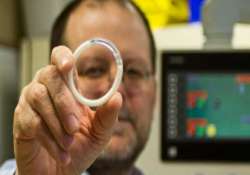Here is an intra-vaginal ring that may prevent HIV
Washington: An inexpensive and easy-to-use intra-vaginal ring filled with an anti-retroviral drug may be extremely effective at preventing the deadly HIV infection in women, scientists say.The novel intravaginal ring implanted with anti-retroviral drug tablets, or

Washington: An inexpensive and easy-to-use intra-vaginal ring filled with an anti-retroviral drug may be extremely effective at preventing the deadly HIV infection in women, scientists say.
The novel intravaginal ring implanted with anti-retroviral drug tablets, or pods, demonstrated sustained and controlled drug release and safety over 28 days, researchers have found.
The ring, designed to prevent transmission of HIV, was tested in pig-tailed macaque monkeys, and is engineered to be inexpensive, all the better for use in developing countries, said corresponding author Marc Baum.
One of the two drug combinations tested in the ring had been shown in three clinical trials to prevent HIV - some of the time - when taken orally, and is the only product approved by the US Food and Drug Administration (FDA) for HIV prophylaxis.
The ring's topical drug delivery has critical advantages over oral therapy. People often fail to take their medications as prescribed.
That probably accounts for some of the wide variation in risk reduction in the three clinical trials, which ranged from 44 to 75 per cent, said Baum, of the Oak Crest Institute of Science, Pasadena.
"Issues such as adherence to a regular dosing schedule are significantly reduced by continuous release of the drugs into the vaginal mucosa independently of coitus and daily dosing," said Baum.
"The ring maintained steady state drug levels in the vaginal tissues, the key anatomic compartment for preventing sexual HIV transmission, and eliminated the concentration troughs encountered with oral medications," said Baum.
"This should boost effectiveness. In addition, systemic levels are so low as to usually be undetectable in topical delivery. That means that side effects are dramatically reduced, or eliminated entirely," said Baum.
The ring is a simple, unmedicated, impermeable elastomer scaffold on which the investigators implanted polymer-coated drug tablets, each containing a different drug.
These deliver the drug directly to the vaginal mucosa, via channels in the elastomer ring, which exposes the pods to vaginal fluids.
The two drug combinations tested include Truvada, which consists of emtricitabine and tenofovir disoproxil fumarate, and Truvada plus maraviroc, which works by blocking the chemokine receptor, CCR5, which is a target entryway of HIV.
The research was published in the journal Antimicrobial Agents and Chemotherapy.
The novel intravaginal ring implanted with anti-retroviral drug tablets, or pods, demonstrated sustained and controlled drug release and safety over 28 days, researchers have found.
The ring, designed to prevent transmission of HIV, was tested in pig-tailed macaque monkeys, and is engineered to be inexpensive, all the better for use in developing countries, said corresponding author Marc Baum.
One of the two drug combinations tested in the ring had been shown in three clinical trials to prevent HIV - some of the time - when taken orally, and is the only product approved by the US Food and Drug Administration (FDA) for HIV prophylaxis.
The ring's topical drug delivery has critical advantages over oral therapy. People often fail to take their medications as prescribed.
That probably accounts for some of the wide variation in risk reduction in the three clinical trials, which ranged from 44 to 75 per cent, said Baum, of the Oak Crest Institute of Science, Pasadena.
"Issues such as adherence to a regular dosing schedule are significantly reduced by continuous release of the drugs into the vaginal mucosa independently of coitus and daily dosing," said Baum.
"The ring maintained steady state drug levels in the vaginal tissues, the key anatomic compartment for preventing sexual HIV transmission, and eliminated the concentration troughs encountered with oral medications," said Baum.
"This should boost effectiveness. In addition, systemic levels are so low as to usually be undetectable in topical delivery. That means that side effects are dramatically reduced, or eliminated entirely," said Baum.
The ring is a simple, unmedicated, impermeable elastomer scaffold on which the investigators implanted polymer-coated drug tablets, each containing a different drug.
These deliver the drug directly to the vaginal mucosa, via channels in the elastomer ring, which exposes the pods to vaginal fluids.
The two drug combinations tested include Truvada, which consists of emtricitabine and tenofovir disoproxil fumarate, and Truvada plus maraviroc, which works by blocking the chemokine receptor, CCR5, which is a target entryway of HIV.
The research was published in the journal Antimicrobial Agents and Chemotherapy.